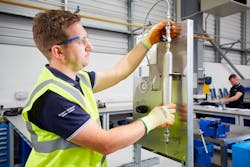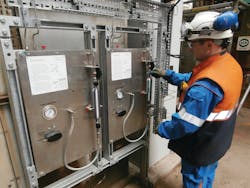5 Tips to Optimize Sample Cylinder Performance in Chemical Plants
“Grab sampling” is an essential step for monitoring process conditions. It involves collecting a sample fluid in a pipeline, tank or system and then analyzing it to validate expected outcomes. If grab sampling takes place regularly, chemical processing plants need to keep their sample cylinders working safely and securely.
Damaged or improperly functioning cylinders can put facilities and their workers at risk. For example, a damaged cap or valve may allow toxic, flammable and/or explosive gases to escape, presenting significant hazards. Corrosion may cause pitting or pinholes, weakening the cylinder and creating a potential explosive hazard when pressurized contents are added. Additionally, damaged cylinders mean your sampling practices may not be accurate. That’s why chemical processing plants need a regular, proactive sample cylinder maintenance program. But understanding whether a small dent in the cylinder body will cause problems or if damage to quick-connect fittings might require attention, can be daunting.Here are five maintenance best practices and tips to help chemical processing plants identify sample cylinder operating issues:
1. Inspect and Test Sample Cylinders Regularly: Frequent sampling – from the sample point to the laboratory and back again – puts cylinders under a lot of stress. Since various employees handle a typical cylinder, including technicians, operations, and laboratory staff, there are multiple points where damage can occur. Process plants also frequently connect or disconnect cylinders from sample points and transport them in truck beds. Through this process, cylinders often incur significant damage and pose potential safety risks to workers and the facility. Chemical processing plants should inspect all sample cylinders for damage and conduct a pressure test at least annually. They also should check with local governing authorities to determine whether they need to re-certify sample cylinders regularly. Even if no such mandate exists, it’s still important to perform the quality checks to ensure the plant is operating safely.
2. Determine Maintenance Needs vs. Replacement: Cylinders may need maintenance between inspections, particularly the valves and quick-connect components. Excessive wear, such as bent quick-connection stems, may occur through improper storage or connections, repeated use and disconnections from the sampling point. Bent stems could reveal that a quick connect is not working as expected. Parts, such as stems, are often replaceable at one-tenth of the cost to purchase a new cylinder.
3. Check for Visible Damage to the Exterior: When there is visible damage to the outside of a cylinder, replacement may be necessary. Obvious damage includes dents, deep scratches or gouges. The cylinder might also become deformed because of over-pressurization. Corrosion damage to the cylinder might also be visible, which usually indicates a degraded internal coating. This type of damage could pose a safety risk in a chemical processing plant and require cylinder replacement.4. Take Immediate Action if Damage Is Present: If visible damage is present, process plants must remove the cylinder from service immediately. The type of damage will determine whether it can be repaired or must be replaced. But during regular chemical plant operation, taking a cylinder out of service quickly may not be simple. To avoid disruptions or unplanned downtime, plant operators should have spare cylinders as well as common components like quick connects on site to allow for rapid changes to be made.
5. Create an Effective Sample Cylinder Maintenance Program: A preventive maintenance plan for sample cylinders can minimize downtime and protect employees by helping plants identify issues before they become problematic. A maintenance program should include a schedule of regular cylinder inspections. This allows you to be in control of when groups of cylinders are removed from service and allows replacements to be ready. The maintenance plan should include visual inspections of all cylinders and their related assemblies and components, which will help technicians determine whether the cylinder is still within safe operating tolerances.
It also should include an analysis of the threads, needle valves, rupture disc valves and fittings. In some cases, a sample cylinder supplier can help a plant establish and support a maintenance program. Suppliers should be able to provide detailed reports on what they found, including images, and have recommendations on what the plant must repair or replace.
About the Author

Tristian McCallion, custom solutions manager, Swagelok Edmonton
Tristian McCallion is the custom solutions manager for Swagelok Edmonton.


